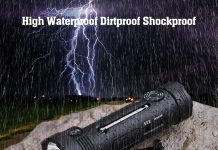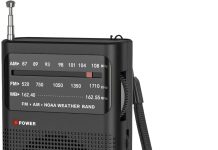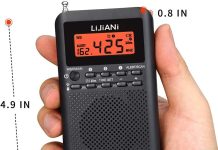In this article, we explore the possibility of adding extra power sources to an emergency weather radio. We all know how crucial it is to have a reliable source of information during severe weather conditions, and often these radios are a lifeline. But what if the power runs out? Is it possible to supplement the existing power sources? Join us as we delve into this topic and discover the options available to ensure your emergency weather radio never goes silent, keeping you informed and safe when it matters most.
Review contents
Power Sources Compatible with Emergency Weather Radios
When it comes to emergency weather radios, having a reliable power source is crucial. While most radios come with their own power options, adding extra power sources can provide extended power supply, backup options, increased portability, and reduce dependency on batteries. In this article, we will explore various power sources compatible with emergency weather radios and discuss their advantages and considerations.
Batteries
Batteries are a commonly used power source for emergency weather radios. They offer convenience and portability, making them a reliable choice. There are different types of batteries available for radios, including alkaline, lithium, and rechargeable batteries. Choosing the right battery depends on factors such as power requirements and budget.
When selecting batteries for your emergency weather radio, consider the battery capacity and life. Higher capacity batteries provide longer runtime before needing replacement or recharge. Additionally, pay attention to the battery life, which refers to the overall lifespan of the battery.
Changing batteries is a simple process. Most radios have battery compartments that are easily accessible. It is important to follow the manufacturer’s instructions for battery replacement to ensure proper functioning of the radio.
Solar Panels
Solar panels are an eco-friendly and renewable power source for emergency weather radios. They harness the power of the sun and convert it into usable energy. Solar charging provides a sustainable solution for powering your radio, especially in outdoor situations where sunlight is readily available.
To effectively use solar charging with your emergency weather radio, it is important to understand the basics. Solar panels are compatible with radios that have a built-in solar charging feature or a separate solar panel input. Check the compatibility of your radio before investing in a solar panel.
Consider the size and output of the solar panel. Larger panels generally provide more power, but they may also be heavier and less portable. The charging time also depends on the sunlight intensity and the panel’s efficiency.
Connecting solar panels to your emergency weather radio typically involves plugging the panel into the designated input or using a compatible charging cable. Refer to the manufacturer’s instructions for proper connection methods.
Hand Crank Generators
Hand crank generators are manual power sources that can be useful during emergency situations. They work by converting mechanical energy from the user’s hand movements into electrical energy. While they might not provide continuous power, they can be a reliable backup option when other sources are unavailable.
To generate power using a hand crank generator, simply rotate the crank handle. The rotation powers the internal components, which then generate electricity. The efficiency of a hand crank generator depends on factors such as the mechanism design and the user’s strength and speed.
When using a hand crank generator, it is important to follow the manufacturer’s instructions for optimal usage. Overexerting force on the crank handle can lead to mechanical damage, and cranking at a consistent pace ensures a continuous and stable power output.
Considerations for usage include the physical exertion required and the duration of power provided by the generator. Hand crank generators are generally less efficient than other power sources, so it is important to have realistic expectations regarding their capabilities.
Power Banks
Power banks, also known as portable chargers, are a versatile power source for emergency weather radios. These compact devices store electrical energy and allow for convenient charging on the go. Power banks come in various capacities, sizes, and charging capabilities, making it important to choose the right one for your radio.
Power banks typically consist of a rechargeable battery and one or more USB ports for charging devices. When selecting a power bank for your emergency weather radio, consider its capacity, which is measured in milliampere-hours (mAh). Higher capacity power banks provide longer runtime for your radio.
Charging power banks is typically done using a USB cable connected to a power source such as a wall adapter or a computer. It is important to use the manufacturer-provided cable and follow the instructions for safe and efficient charging.
Connecting a power bank to your emergency weather radio can usually be done using a USB cable. Many radios have a USB port that allows for easy connection. Ensure compatibility between the power bank and the radio’s charging specifications.
AC/DC Adapters
AC/DC adapters, also known as wall adapters or power supplies, are a reliable and convenient power source for emergency weather radios. These adapters convert alternating current (AC) power from wall outlets to direct current (DC) power suitable for charging electronic devices.
Choosing the right AC/DC adapter depends on factors such as voltage and connector compatibility. It is important to match the voltage requirements specified for your radio. Using an adapter with a higher or lower voltage can damage the radio or result in insufficient power supply.
Before using an AC/DC adapter, ensure that the power output is compatible with your radio’s input specifications. Most radios have a designated input for charging, usually a USB port or a specific charging port. Follow the manufacturer’s instructions to ensure proper usage.
Safety considerations when using AC/DC adapters include avoiding overcharging and regularly checking the power source for any signs of damage. Overcharging can lead to battery degradation or even pose a safety risk. Check the adapter and its cable for any signs of fraying or wear to prevent electrical accidents.
Alternate Power Source Compatibility
The availability of power source options for emergency weather radios may vary depending on the specific radio model. It is important to check the compatibility of different power sources with your specific radio before making any purchase decisions. Radio manufacturers often provide recommendations or guidelines regarding compatible power sources.
Different radios may have varying power requirements and input specifications. Some radios may be designed to work with specific power sources, while others may have more flexibility in terms of compatibility. Refer to the manufacturer’s instructions or contact customer support for clarification on power source compatibility.
Benefits of Additional Power Sources
Adding extra power sources to your emergency weather radio brings several benefits. One of the key advantages is an extended power supply. With additional power sources, you can ensure that your radio remains operational for a longer duration, providing consistent emergency updates and communication.
Having backup options is crucial during emergencies. If one power source fails or becomes unavailable, having alternatives can be a lifesaver. By diversifying your power sources, you minimize the risk of being left without a functioning radio when you need it the most.
Increased portability is another advantage of additional power sources. Some power options, such as power banks and hand crank generators, allow for easy transportation and usage in various outdoor or travel situations. This portability ensures that your emergency weather radio can be utilized wherever you go.
Reducing dependency on batteries is another benefit of incorporating extra power sources. While batteries are a convenient option, they can run out of power quickly, especially during prolonged emergencies. Alternative power sources provide a more sustainable and long-lasting solution, reducing the need for constant battery replacements.
Considerations Before Adding Extra Power Sources
Before adding extra power sources to your emergency weather radio, it is important to consider a few factors. First, review the specifications of your radio to ensure compatibility with the intended power sources. Some radios may have specific requirements or limitations in terms of power input.
Consider your budget when selecting additional power sources. Prices may vary depending on the type, capacity, and brand of the power source. Evaluate your needs, research different options, and choose a power source that suits your budget while providing the necessary functionality.
Weight and size are also important considerations, especially if you plan to use your emergency weather radio during travels or outdoor activities. Determine the level of portability you require and choose power sources accordingly. Some options, such as power banks and solar panels, may be more lightweight and compact than others.
Think about your emergency preparedness plans when selecting additional power sources. Consider your potential use scenarios and the duration of power required. For example, if you anticipate being in areas where sunlight is limited, investing in a solar panel may not be the most practical choice.
Proper Usage and Safety
To ensure the optimal performance and safety of your emergency weather radio and additional power sources, follow these guidelines:
-
Always follow the manufacturer’s instructions for both the radio and the power source.
-
Avoid overcharging your power sources. Overcharging can lead to battery degradation or even pose a safety risk. Unplug the power source once the radio is fully charged.
-
Regularly check the power sources for any signs of damage, such as frayed cables or worn-out connectors. Damaged power sources can be a safety hazard and may not provide reliable power.
-
Maintain the performance of your weather radio by regularly testing it with different power sources. This ensures that the radio is functioning properly and that you are prepared for emergencies.
By adhering to these guidelines, you can ensure the longevity and reliability of your emergency weather radio and maximize the performance of any additional power sources.
In conclusion, adding extra power sources to your emergency weather radio expands its capabilities and ensures continuous functionality during critical situations. Whether you choose batteries, solar panels, hand crank generators, power banks, or AC/DC adapters, it is important to consider compatibility, specifications, and safety guidelines. By selecting the right power sources and following proper usage and safety practices, you can enhance the performance and reliability of your emergency weather radio. Happy preparedness!



























